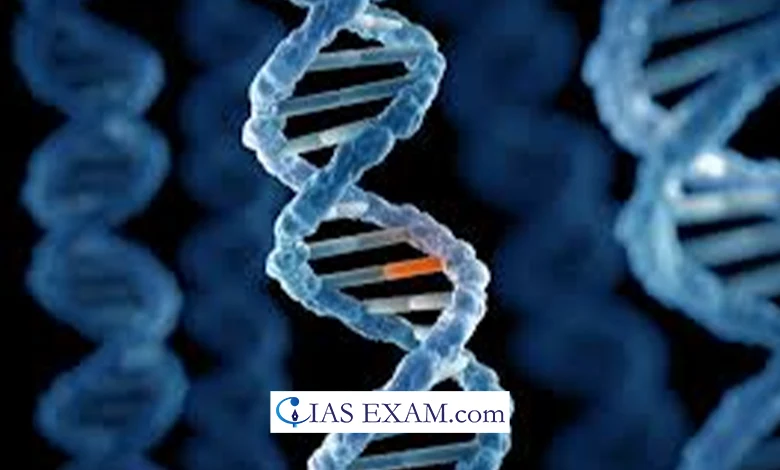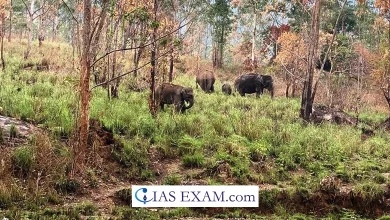Daily Current Affairs for UPSC
DNA mutation caused humans to lack tails
Syllabus: Science & Technology [GS Paper - 3]

Context
- In a recent study, it was found that, 25 million years ago, due to a DNA Mutation which caused humans to lack tails.
About DNA Mutation
- DNA mutation is a process that appears when the succession of nucleotides in the sequence of DNA string changes.
- Natural or induced mutations may occur during DNA synthesis or/and by external damaging agents like UV radiation or chemicals.
- Research indicates that mutations may have different consequences such as having no evident effect to causing diseases or switching expressions.
- Some mutations are neutral or dont have effect; other mutations may be harmful or can be beneficial if they are a positive factor in gene function.
- Ability to differentiate DNA mutations is a key element of studying genetic disorders, evolutionary changes and development of the therapy for genetic diseases.
Details about the process
Genome and Protein Production
- Whenever a cell divides, the whole genetic profile of an organism is copied, with all the information that code contains for manufacturing proteins.
- The genetic segments, or genes, transmit information to build proteins.
- In protein making through selected production, temporary mRNA copies of genes are being produced.
Junk DNA and Regulation
- In higher organisms with multiple complexities like us, genes are evenly distributed throughout the genome, where only 1.5% of genes encode for proteins.
- Mainly, the genome used to be defined as “junk”, but in reality, it “just happened” to regulate the gene expression.
- Transposons like the Alu element which is present in the primates are widely existing in the non coding region termed as the “junk” DNA.
- The fact that Alu elements are mobile and can be replicated and moved around inside the genome at their own will is truly impressive.
- A version of the Alu element present in about 1.4 million copies is distributed throughout the human genome.
- Generally, Alu sequences relocate within the genome and do not generate genomic modifications causing serious health implications.
- But the disturbance is limited; it takes place only in a cell, which contains an Alu element insertion into a crucial gene. It will be the only one perhaps affected.
- The insertion that is produced in the zygote becomes long-term and ever-present in the whole organism when withered the offspring.
Evolutionary Impact
- It was approximately 25 million years ago that Alu genetic element insertion happened in the embryo of an ancestral individual.
- Strange as this is, the subsequent absence of the tail of this creature resulted in the birth of the first goat-ape relating to the black coloured apes of today.
- A research team composed of scientists from New York University (NYU) reported on this discovery in a Nature paper in February.
- The researchers then found a polymorphism in the Alu element, which is regarded as a potent DNA sequence for enhancing the expression of the homeobox gene TBXT, notorious for regulating limb development.
- The interference causes normal gene building to be disrupted, therefore, reduced tail protein production and tail itself may result.
- Malfunction of the TBXT protein may be one of the reasons for the appearance of neural tube defects, moreover compared to non mutated embryos might be achieved by compensation genetic mechanisms.
- Special comparison of TBXT mRNA in Human and mouse stem cells demonstrated lack of protein production.
- This research underlines the fact that “junk” DNA is not, in fact, detrimental to evolutionary processes and the formation of traits.
- Decoding mechanisms responsible for Alu element insertions becomes an evidence of complex evolutionary functions and trustable origins of various species.
Conclusion and Way Forward
- As a result of the current research, scientists managed to identify the cause of human anthropoids and, moreover, pointed out how the evolutionary processes can be complex.
- Researchers can unveil base processes in genetic disease and evolution just by taking advantage of complete data they gather about gene mutations impact on them.
- It is the uncovering of non-coding DNA which is responsible for filling gene expression, mutations also in the inheritance of traits that assists people to comprehend the design of how species evolution takes place and the further growth.
Source: The Hindu
UPSC Mains Practice Question
Q.“Discuss the implications of a recent study revealing a DNA mutation 25 million years ago as the cause for the absence of tails in humans. How does this finding contribute to our understanding of genetic mutations and evolutionary processes?”[150 Words]





.png)



